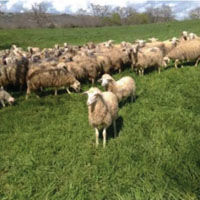An on-farm rotational grazing trial: restricting access time to pasture did not affect the productivity of a dairy sheep flock in spring

Accepted: 6 October 2020
HTML: 73
All claims expressed in this article are solely those of the authors and do not necessarily represent those of their affiliated organizations, or those of the publisher, the editors and the reviewers. Any product that may be evaluated in this article or claim that may be made by its manufacturer is not guaranteed or endorsed by the publisher.
Highlights
- The challenge lies in comparing data of dairy sheep productivity collected at real farm condition with previous data measured in Mediterranean research stations.
- In this study, no difference in milk production was found between ewes allowed to graze two hours and four hours per day in spring.
- The ewes’ herbage intake rate correlates positively with pasture quality and a mixed pasture with a high share of legumes led to a high intake rate.
- We believe that the outcomes in this manuscript can contribute to increase knowledge about the sustainable management of small ruminant dairy farms in the contest of rural areas.
In the Mediterranean area, semi-extensive mixed farming systems characterise the inland landscape and guarantee the maintenance of several agroecosystem services. Rationed and rotational grazing have been proposed as efficient agroecological practices for sustainable intensification. Previous studies have highlighted that, during spring, restricted access time to pasture of below four hours per day decreases herbage intake and milk production of rotationally stoked ewes. The aim of this study was to assess the effect of restricted access time on daily herbage intake and milk productivity of Sarda ewes under rotational grazing management in a real farm located in southern Tuscany. The entire flock of 145 lactating ewes was allotted two homogenous groups and rotationally stoked on a grass-legume mixed pasture and fed about 1.7 kg of DM ewe–1 d–1 of supplementation. Each group was then assigned to the following treatments: two hours per day of access time to pasture, from 10:00 to 12:00 CET, and four hours per day of access time to pasture, from 10:00 to 14:00 CET. Data on herbage yield and quality, dry matter intake and milk yield were collected from April 5 to May 10, 2018. The rotational grazing schedule was conducted allowing for abundant herbage and exploiting high-nutritive biomass of the upper horizon sward. The results of our on-farm experiment showed that restricting daily access time to pasture down two hours did not reduce the potential daily herbage intake and the milk performance of dairy ewes rotationally stocked on a mixed pasture in spring. Our study also highlighted the capacity of ewes to self-regulate the herbage intake in order to meet their energy requirements, when neutral detergent fibre is not a limiting factor. Our outcomes should encourage researchers and farmers to co-design further on-farm experiments.
How to Cite
PAGEPress has chosen to apply the Creative Commons Attribution NonCommercial 4.0 International License (CC BY-NC 4.0) to all manuscripts to be published.

 https://doi.org/10.4081/ija.2020.1711
https://doi.org/10.4081/ija.2020.1711



